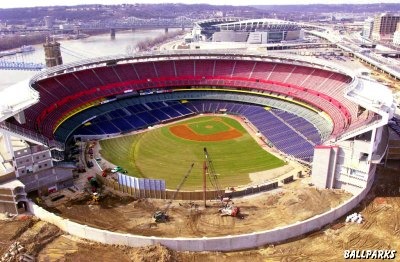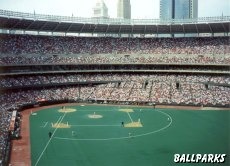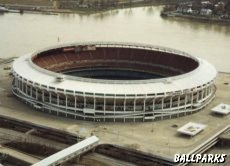Riverfront Stadium
A.K.A Cinergy Field Cincinnati, OhioTenants: Cincinnati Reds (NL); Cincinnati Bengals (NFL, 1970-1999) Architects: Heery & Heery and Finch, Alexander, Barnes, Rothschild & Pashal Cincinnati Reds tickets:
Location: Left field (NE), Pete Rose Way, Broadway and Firstar Center (Riverfront Coliseum); third base (NW), Pete Rose Way on September 10, 1985; first base (SW), Roebling Suspension Bridge and the Ohio River; right field (SE), Mehring Way, railroad tracks, and the Ohio River. Dimensions: Left field: 330 feet (1970), 325 feet (2001); left-center: 375 feet (1970), 370 feet (2001); center field: 404 feet (1970), 393 feet (2001); right-center: 375 feet (1970), 373 feet (2001); right field: 330 feet (1970), 325 feet (2001); backstop: 51 feet (1970), 41 feet (2001). Fences: Left field: 12 feet (wood, 1970), 8 feet (wood, 1984); left-center: 12 feet (wood, 1970), 8 feet (wood, 1984), 14 feet (wood, 2001); center field: 12 feet (wood, 1970), 8 feet (wood, 1984), 40 feet (wood, 2001); right-center: 12 feet (wood, 1970), 8 feet (wood, 1984), 14 feet (wood, 2001); right field: 12 feet (wood, 1970), 8 feet (wood, 1984).
Riverfront Stadium was the third of the National League’s infamous "cookie-cutter" stadiums, debuting five years after Atlanta-Fulton County Stadium, four years after St. Louis’s Busch Stadium and two weeks before Pittsburgh’s Three Rivers Stadium. It was the first stadium to have its entire field covered by Astroturf, except for the cutouts around the bases and pitcher’s mound. Construction on the press box and stadium club was never finished. In its very first season it managed to host an All-Star Game, a playoff series, and a World Series. Before Riverfront Stadium opened on June 30, 1970, the Reds had spent 58 years playing at intimate Crosley Field, baseball’s only park with a two-tiered outfield. After more than three decades of talking about building a ballpark on the scenic Ohio riverfront, Cincinnati finally made it a reality. In 1997, Cinergy Corporation, a Cincinnati based utility, reached an agreement with the Reds to rename the stadium Cinergy Field. That name was retained until the ballpark was demolished in 2002. Before the beginning of the 2001 baseball season, the outfield stands were removed to facilitate construction of Great American Ball Park, the new ballpark built next to Riverfront Stadium. Another project which was undertaken was to replace the artificial turf with natural grass.
Trivia:
More on Riverfront Stadium: Recommended Reading (bibliography):
Help us provide a better web site by completing our feedback form 2001 aerial view of Riverfront Stadium © 2001 by Paul Leskovac. Updated April 2005 Tickets to Cincinnati Reds, NCAA Basketball Tournament, College Football Bowl, NCAA Football, Tennessee Titans and Paul McCartney provided by Ticket Triangle. BALLPARKS © 1996-2014 by Munsey & Suppes.
|









